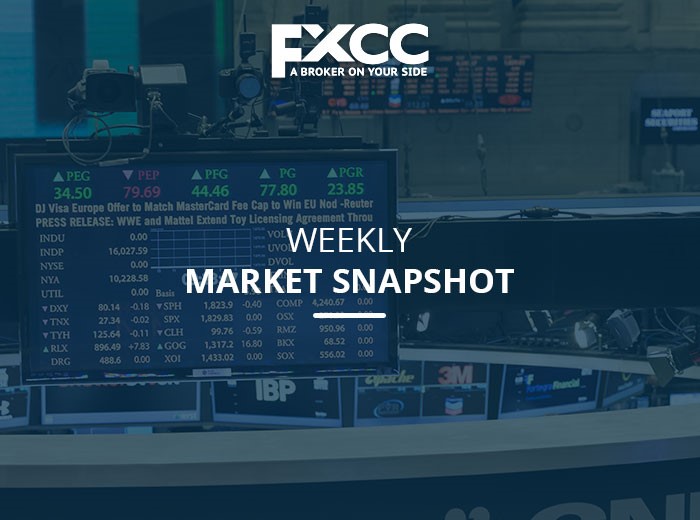It was a week of GDPs this week. The USA economy’s final GDP reading for 2020 came in at –3.5%, the worst performance since 1946 recorded during the aftermath of WW2.
The Q4 metric for US GDP growth came in at 4%, right on the forecast and falling back from the blistering 33% COVID-19 recovery pace recorded in Q3 before the US began to reclose specific sectors of the economy (and society).
On Friday morning, France and Germany published bullish GDP figures for Q4 2020. Analysts and traders were looking towards these data to indicate the pace of the Eurozone’s recovery.
Germany surprised the markets by posting a 0.1% growth figure in Q4, although for 2020 the economy shrank by -5%. France recorded a -1.3% contraction in Q4, better than the prediction of -4% and coming after the record 18% growth in Q3. Spain’s GDP also beat forecasts, coming in at 0.3% growth for the final quarter of 2020.
However, both France and Germany’s latest pandemic lockdowns gathered momentum in late December; therefore, the latest GDP figures can’t point to a sustainable recovery. Q1 2021 metrics will be dire due to the newest round of lockdowns throughout the trading bloc and broader EU region. Like the UK, France and Germany also face inevitable double-dip recessions in Q1 2021.
European equity indices slumped when the markets opened on Friday but recovered marginally once the bullish Eurozone GDP data got published. At 9:30 am UK time the DAX traded down -0.77%, the CAC down -0.88% and the UK FTSE 100 down -0.69%. The DAX and CAC are now trading in negative territory year-to-date, while the FTSE 100 is up 0.50%.
The futures for US equity markets point to a fall once New York opens this afternoon, the SPX 500 traded down -1.04% and the NASDAQ 100 down -1.53%. If those levels maintain at the market open, these leading US markets will turn negative year-to-date. Weekly the SPX is down -2.35%, and the NASDAQ is down -2.55%.
This week’s moderate sell-off in many western global markets could be due to four factors.
- The Biden relief rally is over. Analysts and investors are contemplating the massive tasks the president must address in both the economy and society, while delivering vaccines to hundreds of millions of US citizens.
- The various partial lockdowns in Europe and the USA have throttled any sustained recovery. Meanwhile, undignified arguments over vaccine supply and distribution have broken out between the UK and the EU.
- Profit-taking could be taking place. After the significant growth experienced in 2020, it would come as no surprise if many investors (particularly retail investors) cashed in their chips and walked away from the table.
- The massive surge in retail day-trading could be fizzling out. Many US-based traders have accessed the options market through gamified platforms such as Robin Hood’s to help push stocks (especially tech stocks) to stratospheric highs. Now that earnings are getting published it’s becoming increasingly difficult to justify the valuations based on realistic price v earnings ratios.
USD rises during the week while crude oil maintains its recent gains
The US dollar recorded significant gains versus its peers during the week. Investors and traders in USD were encouraged by the Federal Reserve chair Jerome Powell’s recent statements concerning the monetary policy he intends to maintain. The Fed is not increasing the bond-buying/QE programme and Mr Powell also indicated no change to the current 0.25% interest rate over the medium term.
The dollar index DXY was up 0.27% during Friday’s early session and up 0.57% weekly, maintaining position above the key 90.00 level-handle at 90.70. EUR/USD is down -0.54% weekly while trading close to flat and near the daily pivot pint during Friday’s London-European session.
GBP/USD has surrendered the gains recorded during the week down -0.11%. In Friday’s early session the currency pair traded down -0.38% while threatening the breach S1.
The safe-haven appeal of JPY and CHF has faded this week. USD/JPY is up 1.09% weekly up 0.51% on the day. USD/CHF is up 0.53% weekly and up 0.10% on the day. USD has also clawed back recent losses versus both antipodean currencies this week; AUD/USD is down -0.90%, and NZD/USD is down -0.22% weekly.
Crude oil has risen significantly in 2021. The fuel for global growth is up 8.25% YTD and 8.54% monthly. That rise has slowed this week, cut back to 0.48%. The markets have factored in the winter months’ stockpiles and deliveries in Europe and America, and according to IMF opinion this week global growth will not return until the vaccines get rolled out and are proven to work.
Precious metals have experienced mixed fortunes this week. Gold is trading close to flat for the week, down -0.06% but up 0.76% on Friday at $1,853 per ounce. Silver has risen sharply this week, up 6.18% weekly and up 2.31% on Friday to trade at $26.95 per ounce.
Calendar events to monitor during the week commencing Sunday, January 31
On Monday, February 1, several IHS Markit manufacturing PMIs for Europe get published. Italy, France, Germany and the wider Eurozone area should show falls in January.
Markit also forecasts the UK to reveal a slump. However, all the countries’ readings should remain above the 50 levels separating contraction from growth. Mortgage approvals, consumer credit and house price data get published for the UK during the morning session, and all three readings should remain close to previous figures.
The ISM manufacturing PMIs for Canada and the USA will get published in the afternoon. Construction spending in the USA could fall to 0.5% when December’s figure becomes published.
The Aussie dollar will come under scrutiny during Tuesday’s Sydney session as the RBA reveals its interest rate decision. The rate should remain unchanged at 0.1%.
As the London-European session opens, Italy’s latest GDP figures will get published. Analysts forecast a year-on-year fall of -5.8% and Q2 2020 of -2.3%. Reuters predict a decrease in the EA’s GDP to -6.0% in 2020 and -2.2% for Q4.
Europe’s IHS Markit services PMIs will get shared during Wednesday’s London-European session. France, Spain, Italy and the EA will show falls according to the analysts at Reuters and Bloomberg.
The UK services PMI will have the most significant deterioration, it’s forecast to come in at 38.8 in January, falling from 49.4 in December. Such a fall could impact on the value of GBP versus its peers when the data gets broadcast. According to analysts, European inflation could have risen to 0.1% annually and up 0.5% in January.
The Markit services reading for the USA should indicate an improvement in January, and the composite might come in at 58, well above the 50 contraction-expansion levels. The ADP employment number is forecast at 50K, a significant improvement versus the -123K reading previously. The healthy Markit composite added to encouraging job numbers could positively impact USD’s value versus its peers.
Construction PMIs get delivered on Thursday for Germany and the UK, construction hasn’t stopped during the UK lockdown; therefore, the reading will remain above 50 at 54.6 according to analysts. The UK’s Bank of England will reveal the latest interest rate decision and advise if there’s any change to the QE programme. Both monetary policy issues should remain unchanged.
The weekly jobless claims figure for the US gets delivered by the BLS on Thursday afternoon, the latest readings have fallen below 900K per week, and the hope is this trend will continue to show a decline. According to analysts, factory orders should show signs of improvement; the measurement will rise from 1% to 1.7% for January. The optimism generated by these two figures could positively impact USD’s value.
On Friday we’ll receive the second NFP data of 2021. After January’s figure contained December’s seasonal jobs, February’s will be more realistic regarding the jobs created in the world’s biggest economy. Analysts forecast only 80K jobs created, improving from the shock -140K job losses previously recorded. The US’s unemployment rate should remain at 6.7%, while Canada’s should fall from 8.8% to 8.7%. The latest factory orders data from Germany, France’s balance of trade, Italy’s retail sales, and UK house prices (according to the Nationwide bank) are readings that could affect the value of EUR and GBP if the results miss or beat the analysts’ predictions.


